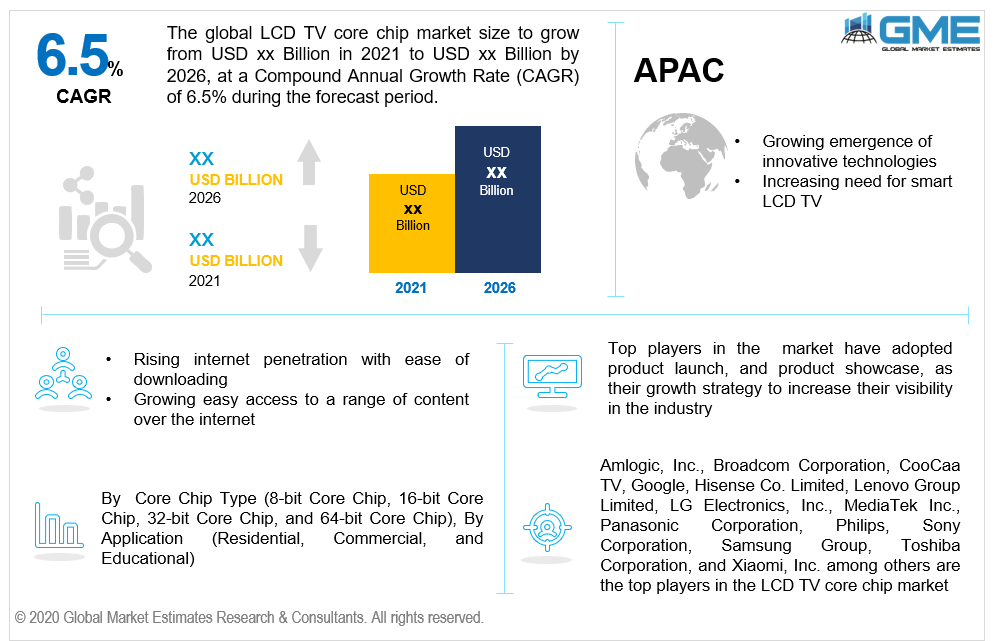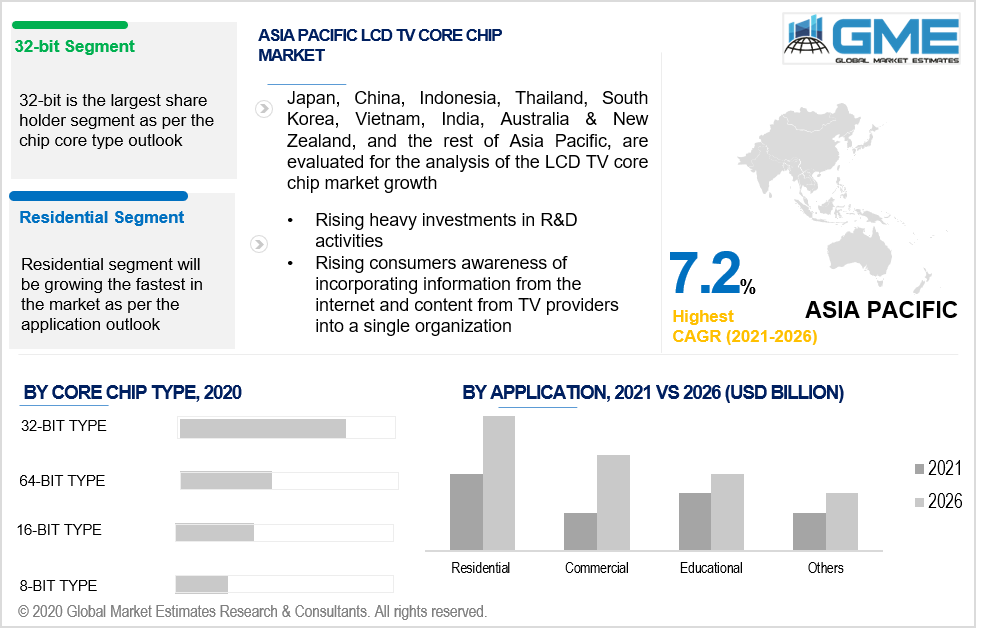
Global LCD TV Core Chip Market Size, Trends & Analysis - Forecast to 2026 By Core Chip Type (8-bit Core Chip, 16-bit Core Chip, 32-bit Core Chip, and 64-bit core chip), By Application (Residential, Commercial, and Educational), Competitive Landscape, Company Market Share Analysis, and Competitor Analysis
The liquid-crystal display (LCD) TV core chip combines an LCD TV with a processor core chip to provide a computational experience via television. The combination of an LCD TV and a core chip improves the processing capabilities of television sets. The integration of core chips into LCD TVs rewards consumers when it combines input from the web and information from television networks into a singular element known as smart television.Furthermore, LCD TV core chip installation eliminates the need for a discretely installed set-top box. Users can reach online stores, websites, and stream a range of content via smart TVs.
The market drivers which contribute to the LCD TV Core Chip market include the increasing internet penetration, ease of downloading, and quick access to content over the internet, heavy investments in R&D activities by major players in regional markets.Because of the technological proliferation in the LCD TV industry, innovations have arisen. The addition of core chip processors to LCD TVs has boosted the market's growth. The television industry has seen a significant shift towards the use of smart TVs over the years. This change can be attributed to a rise in global urban populations and a highly tech-savvy population. The combination of an LCD TV and a core chip improves the processing capabilities of television sets. It is, first and foremost, a technical fusion of LCD televisions and computers.The incorporation of core chips into LCD TVs improves the user's experience by combining knowledge from the internet with content from television providers. As a direct consequence of this integration of technology, the LCD TV core chip market is growing. Moreover, the deployment of LCD TV core chips excludes the necessities for standalone set-top box setup.Users will use the core chips to access advanced and sophisticated features like apps, video streaming, and syncing through various devices. The LCD TV core chip allows users to browse products on digital retailers' apps and websites, also can view their preferred content. The incorporation of these features into television sets attracts more potential buyers to the market, resulting in increased market growth. Core chips may be used to upgrade the built-in device or processor in LCD televisions, similar to those used in smartphones. The growth of the LCD TV core chip market has been fueled by the widespread use of internet services and the number of internet users around the world.

Based on core chip type, the market is categorized into 8-bit core chip, 16-bit core chip, 32-bit core chip, and 64-bit core chip.
During the projected timeframe, the 32-bit market is estimated to generate a major share of the revenue.32-bit color supports 4,294,967,296 color combinations, allowing for more compelling gradients, shadows, and transparencies. As the number of colors supported grows, more memory is needed. Almost all video cards today, however, have enough memory to accommodate 32-bit colors at most resolutions. Up to 16-bit colors can be supported by older computers and video cards.
Based on application, the market is categorizedinto residential, commercial, and educational.
The residential industry accounts for a significant portion of the overall LCD TV core chip market. The emergence of the residential usage market segment has resulted in a substantial rise in consumer acceptance of smart LCD TVs. The LCD TV core chip market has become extremely competitive as a result of the presence of many domestic and foreign vendors. Established players' fierce rivalry has stifled new entrants' ability to enter the market. Furthermore, the LCD TV market's high reliance on technology providers for starting a company limits growth opportunities and necessitates large investments. Technological advances in the LCD TV core chip industry necessitate significant R&D expenditures. Innovative technology, such as LED Smart TVs, poses a significant challenge to business growth.

As per the geographical analysis, the market can be classified into North America (the US, Canada, and Mexico), Asia Pacific (India, China, Japan, Malaysia, Singapore, and Rest of Asia Pacific), Europe (Germany, United Kingdom, Italy, France, Spain, Netherlands, and Rest of Europe), Middle East & Africa and Central South America.
In North American countries like the USA and Canada, LCD Smart TVs are becoming more prominent.This has fueled the development of the LCD TV core chip market in North America. European countries are thought to be early adopters of technology. Furthermore, the European Union has always been a leader in promoting environmental sustainability and emphasizing the use of environmentally friendly goods. LCD TVs, which are both energy-efficient and environmentally friendly, are in high demand in this area.Europe and North America have seen significant sales increases in the worldwide LCD tv core chip sector.In recent years, the demand for LCD Smart TVs has grown in North America, while the market in Europe has gained traction as the government emphasizes the use of eco-friendly and energy-efficient devices. The Asia Pacific market reportedly retains a significant share in the global LCD TV core chip market in terms of volume, owing to the powerful existence of LCD TVs and LCD TV core chip producers in this region. The developing economies of the APAC region, have the majority of key LCD TV core chip producers.As a result, LCD TVs with core chips are more affordable in the regional market, fueling demand and contributing to regional market development.
Amlogic, Inc., Broadcom Corporation, CooCaa TV, Google, Hisense Co. Limited, Lenovo Group Limited, LG Electronics, Inc., MediaTek Inc., Panasonic Corporation, Philips, Sony Corporation, Samsung Group, Toshiba Corporation, and Xiaomi, Inc.are the top players in LCD TV core chip market.
Please note: This is not an exhaustive list of companies profiled in the report.
We value your investment and offer free customization with every report to fulfil your exact research needs.
The Global LCD TV Core Chip Market has been studied from the year 2019 till 2026. However, the CAGR provided in the report is from the year 2021 to 2026. The research methodology involved three stages: Desk research, Primary research, and Analysis & Output from the entire research process.

The desk research involved a robust background study which meant referring to paid and unpaid databases to understand the market dynamics; mapping contracts from press releases; identifying the key players in the market, studying their product portfolio, competition level, annual reports/SEC filings & investor presentations; and learning the demand and supply-side analysis for the LCD TV Core Chip Market.

The primary research activity included telephonic conversations with more than 50 tier 1 industry consultants, distributors, and end-use product manufacturers.

Finally, based on the above thorough research process, an in-depth analysis was carried out considering the following aspects: market attractiveness, current & future market trends, market share analysis, SWOT analysis of the company and customer analytics.

Tailor made solutions just for you
80% of our clients seek made-to-order reports. How do you want us to tailor yours?
OUR CLIENTS